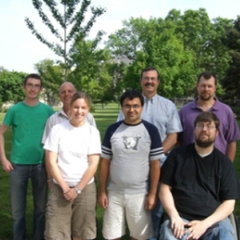March 28, 2014
Macdonald lab researchers publish in Journal of Physics B

Researchers in the James R. Macdonald Laboratory in K-State's physics department have published "Elucidating isotopic effects in intense ultrafast laser-driven D2H+ fragmentation" in the January 2014 issue of the Journal of Physics B: Atomic, Molecular and Optical Physics.
Authors of the article include Itzik Ben-Itzhak, physics professor and director of the laboratory; Kevin Carnes K-State research professor; A. Max Sayler, K-State doctoral student; Jarlath McKenna; Bishwanath Gaire, K-State doctoral student; and Nora G Kling, K-State doctoral student.
The authors’ description of their work and explanation of the results were deemed significant enough by the journal to select a figure from the paper — showing the energy landscape of the molecule — to be the cover image for the issue containing the article. Research into these and similar systems is ongoing.
Using coincidence 3D momentum imaging, researchers from Kansas State University reveal that D2H+ has a propensity to favor certain fragmentation channels when subjected to intense ultrashort laser pulses.
As an important player in the chemistry of our universe, the triatomic hydrogen molecular ion has attracted much research interest over the years including infrared spectroscopy measurements, dissociative recombination studies, and astronomical observations. Recently, however, it has gained attention from the strong-field laser community since, being the most basic stable polyatomic molecule, it could be pivotal to our fundamental understanding of laser-driven molecular dynamics. Knowledge gained from this ‘simplistic’ system should help pave the way to a better understanding of the complex dynamics of larger molecules and lay down a benchmark for advancing theory.
Earlier experimental work in this direction explored for the first time the strong-field fragmentation of the H3+ and D3+ molecules, where D is the heavy hydrogen isotope with an extra neutron in the nucleus. Now, new research achieves another milestone by tackling the isotopologue D2H+ — published in the journal. In many ways this member of the H3+ family could be considered more exciting than its counterparts as it naturally poses the question of whether there are any isotopic effects that arise due to the mass-asymmetry of the D2H+ ion. Indeed, this is the theme of the research presented by the authors as they seek to address this question.
Using a crossed-beams coincidence 3D momentum imaging method the authors are able to uniquely separate all the possible fragmentation channels of D2H+ in intense — up to 1016 Watts/cm2 — ultrashort — 7 and 40 × 10-15 second — laser pulses. This enables them to look at the branching ratios of break-up channels differing by the isotope, such as D2H+ fragmenting to D2++H or HD++D. Notably the authors report sizeable differences in some channels. For example, they show that for dissociative ionization there is a large difference — by more than a factor or five — in the branching ratios of the two-body channels, namely, H++D2+ dominates over D++HD+. Other channels, particularly the dissociation channels H++D2 and D++HD, have little or no difference.
About the authors
The experiments presented in this work were carried out in the James R. Macdonald Laboratory K-State's physics department under the leadership of Ben-Itzhak. The group’s work is predominantly centered around studies of laser molecular-ion interactions, collisional fragmentation experiments and attosecond science. This work benefited from the theoretical insight provided by Brett Esry, university distinguished professor of physics and Ernest K. and Lillian E. Chapin professor of physics. Find out more information about the research conducted at the laboratory.
